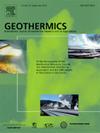利用近地表热异常成像经济有效地探测隐伏地热资源——以山西为例
IF 3.9
2区 工程技术
Q3 ENERGY & FUELS
引用次数: 0
摘要
地热能是一种环境友好的替代能源,但由于勘探开发新区域成本高、风险大,限制了地热能的广泛和大规模利用。常规勘探方法在探测地下流体和热量组合方面面临重大挑战,因此需要更高效、更经济的地热勘探技术。本文提出了一种利用近地表热异常探测隐伏地热资源的方法。在20平方公里的范围内测量了60口井的温度,深度从50 ~ 200 m不等。绘制了归一化温度等值线图,圈定了两个明显的地热甜点:西部和东部异常区,最大异常幅度分别为100%和30%。西部地区通过钻井确认了地热资源,从800 m深的基底储层产出50℃、流量40 L/h的热水。东部地区的轻微热异常可能是由于城市热岛效应而不是深部热。这些发现表明,利用近地表热异常进行高效经济的地热勘探和研究城市热岛效应对周围地下热环境的影响具有潜力。本文章由计算机程序翻译,如有差异,请以英文原文为准。
Imaging near-surface thermal anomalies for cost-effective detection of hidden geothermal resources: A case study in Shanxi province, North China
Geothermal energy is an environmentally friendly alternative energy source, but its widespread and large-scale utilization is limited by the high cost and risk for exploring and developing new areas. Conventional exploration methods face major challenges in detecting ground fluid and heat assemblage, highlighting the need for more efficient and economical geothermal exploration technologies. This paper proposes a method for detecting hidden geothermal resources by focusing on near-surface thermal anomalies. The temperature was measured over a 20 square kilometer area, which included 60 wells ranging in depth from 50 to 200 m The normalized temperature contour maps were drawn to delineate two distinct geothermal sweet spots: the western and eastern anomaly areas, which have maximum anomaly amplitudes of 100 % and 30 %, respectively. Geothermal resources in the western areas were confirmed through drilling, which produced hot water at 50 °C and a flow rate of 40 L/h from an 800-meter deep basement reservoir. The slight thermal anomaly in the eastern area is likely due to the Urban Heat Island effect rather than deep heat. These findings demonstrate the potential of using near-surface thermal anomalies for efficient and economical geothermal exploration and for studying the urban heat island effect on the surrounding underground thermal environment.
求助全文
通过发布文献求助,成功后即可免费获取论文全文。
去求助
来源期刊

Geothermics
工程技术-地球科学综合
CiteScore
7.70
自引率
15.40%
发文量
237
审稿时长
4.5 months
期刊介绍:
Geothermics is an international journal devoted to the research and development of geothermal energy. The International Board of Editors of Geothermics, which comprises specialists in the various aspects of geothermal resources, exploration and development, guarantees the balanced, comprehensive view of scientific and technological developments in this promising energy field.
It promulgates the state of the art and science of geothermal energy, its exploration and exploitation through a regular exchange of information from all parts of the world. The journal publishes articles dealing with the theory, exploration techniques and all aspects of the utilization of geothermal resources. Geothermics serves as the scientific house, or exchange medium, through which the growing community of geothermal specialists can provide and receive information.
 求助内容:
求助内容: 应助结果提醒方式:
应助结果提醒方式:


